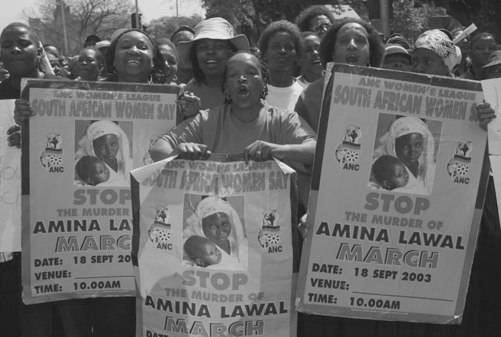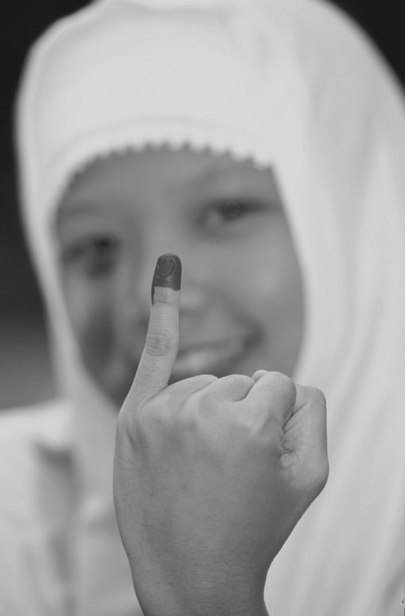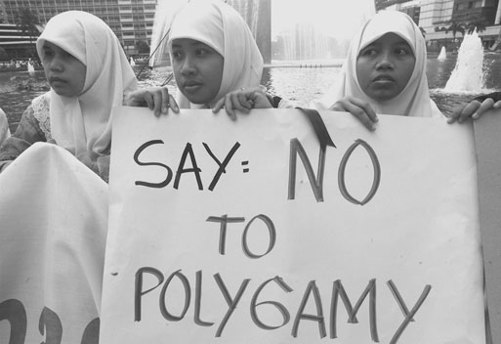Feminism (18 page)
Authors: Margaret Walters
Tags: #Social Science, #Feminism & Feminist Theory, #Anthropology, #Cultural, #History, #Social History, #Political Science, #Human Rights

16. Anti-female circumcision poster, Sudan.
124
Africa
The problems of Africa are particularly complex. ‘African
women have always defined and carried out their own struggles . . . [it] dates far back in our collective past’, argues
Amina Mama. Different women are oppressed differently:
feminism must acknowledge ‘differences of race, class and
culture’. Feminism in Africa is heterosexual, pronatal, and
concerned with ‘bread, butter and power’ issues. Genital
mutilation, as a way of suppressing unruly female sexuality,
is still carried out in some African countries. It is not an
inherently Muslim practice, but has become part of the anti-woman stance adopted by certain fundamentalists.
Feminists across th
In Nigeria in 2000, a 30-year-old Muslim, Amina Lawal, was
condemned by a sharia court to be stoned to death after she
had a baby outside marriage – she had apparently been
e w
raped. The issue received worldwide coverage because, iron-orl
d
ically, the Miss World beauty contest was to be held in
Nigeria. Various contestants protested: a few flatly refused
to participate; others claimed that they at least intended to
speak out against the ruling. A fashion writer’s comment that
the Prophet Mohammed might well have chosen one of the
contestants as his wife led to riots; militant Islamic groups
described the contest as a ‘parade of nudity’ which would
promote promiscuity and Aids. But many local women found
the courage to demonstrate in angry protest.
theorists since her day, she tended to romanticize traditional customs and the veil, and more than half-regretted the growing number of women wearing Western clothes, at least at home. But when her Turkish friend, a woman called Zegreb Hamun, visited 125

17. Women protest against the death sentence of the Nigerian Amina Lawal, 2003.
her in England, the tables were neatly, and comically, turned on Ellison. Hamun also published a book of her letters to Ellison, called
A Turkish Woman’s European Impressions
. She dismissed a London Ladies’ Club as dull and apathetic, lacking the ‘mystery and charm’ of the harem. But a visit to the Houses of Parliament left her sharply critical:
But my dear, why have you never told me that the Ladies’ Gallery is a harem? A harem with its latticed windows! The harem of the Government! . . . You send your women out unprotected all over the world, and here in the workshop where your laws are made, you cover them with a symbol of protection!
Some recent Western academic feminists theorize endlessly and not very helpfully about the veil and the harem; they seem to
Feminists across th
deconstruct in order to glamorize, and indulge in their own curious version of ‘orientalizing’ fantasy. Veiling has certainly been, and remains, an important, and occasionally controversial, issue in some Muslim societies. In 1923, Hudu Sha’rawi, the wife of a welle w
known Egyptian politician, had caused a sensation when she
orl
returned from a trip abroad and publicly removed her veil, though
d
she kept her head covered. But much more importantly, she went on to set up women’s groups that fought for better education, the right to vote and run for office, and for reforms concerning the family. Like women since, whether in Egypt or other Muslim countries, she was trying to establish a specifically Islamic feminism.
Five years later, a Lebanese woman, Naxira Zain as Din, published a book arguing that the ‘veil is an insult to men and women’, and arguing that the oppression of women could not be justified by appeals to Islam. (Religious scholars incited demonstrations against her book.) On the other hand, many women have argued that the veil can be liberating; that it allows them to observe, rather than be observed, not only freeing them from the vagaries of fashion but helping them avoid sexual harassment. It is, of course, 127

18. A Sundanese Muslim girl displays her inked finger, proof of having
voted. Sundanese women were enfranchised in 1964.
128
impossible to lump all Islamic nations together; moreover, in most Muslim countries (contemporary Egypt is a good example) there are considerable and very visible differences between classes, but also between those women who live in the country and those in the great cities like Cairo and Alexandria. Many Muslim women, especially in big cities, are comfortable unveiled. On the other hand, some Turkish women, for example, have argued that it is in fact the veil that makes it possible for them to enter public life, that gives them the freedom to work, confidently, as teachers or doctors.
Arguments occasionally arise in Muslim communities in the West.
Schoolgirls in France protested bitterly when they were forbidden to wear headscarves. In England, one Muslim schoolgirl made newspaper headlines when she insisted on wearing, not simply a headscarf and long, loose trousers, but a robe reaching to the ground. But that seems to have been an isolated case; any morning
Feminists across th
on London streets a few girls heading for school can be seen wearing exactly that.
Problems are more acute in the Muslim theocracies. Saudi Arabia is
e w
an extreme example, with its heavy and compulsory veiling of
orl
women, who cannot even walk on the street unless accompanied by
d
a male relative, and need male permission to travel and work. Iran, on the other hand, has a long history of women taking independent political action. Even in the 19th century, there were women who wrote eloquently about what they described as the pitiful state of many Iranian women; one issued a pamphlet titled
The
Shortcomings of Men
. In the early 20th century, women as well as men demanded constitutional, as well as gender, rights; and women were among the strikers who sought sanctuary at the British embassy in 1906. But their activism was ignored, and in the new constitution of 1906, they were barred from politics and informed that ‘women’s education and training should be restricted to raising children, home economics and preserving the honour of the family’.
But schools for girls were established, and women’s associations flourished; in 1911 a book by an Egyptian activist, Ghassem Amin’s
Freedom of Women
, was translated into Persian – and was bitterly 129
attacked by the religious authorities. In 1931, women won the right to ask for divorce under certain conditions; in the next decade, a national education system was established, for girls as well as boys; and in 1936, the first women students attended Tehran University, and by 1978 women made up 33% of the workforce. In 1962, women finally won the right to vote, and to stand for office. In Kuwait, women finally gained the vote and the right to stand for office in 2005.
Iranian women were active during the Islamic Revolution of 1978, and various women’s organizations were formed. But since that time, official attitudes to women have hardened. In 1979, Ayatollah Khomeini insisted that Iranian women working for the government wear the veil, dismissed women judges, repealed a family protection law, in effect denying women the right to divorce, and banned contraception and abortion. Women could be flogged and fined if they refused to comply with a strict dress code; married women had to get their husband’s consent before taking a
minism
job. Custody laws were passed that denied mothers rights over
Fe
their children. But even in those dark days, women’s education was not very different to men’s; women could still vote, become members of parliament and hold political office, and work outside the home. In 1998, women made up 52% of Iranian university students.
At the same time, many women found their lives more difficult after the Revolution; it was more difficult for women to initiate divorce or to obtain custody of their children; and the minimum age for marriage for girls was lowered first to 13, and then to 10. Women could only acquire a passport with the written consent of their fathers or husbands. Wearing the veil became obligatory; though some women still welcomed the veil as symbol of their rejection of a secular, Westernized lifestyle.
Some secular feminists left the country; others demonstrated against the new order on International Women’s Day 1979; still 130
others rejected the imposition of strict dress codes. Dissent was effective and widespread because it was often informal; spread through Xeroxed leaflets and pamphlets, wall newspapers, debates on the streets, women’s magazines. Though feminism was forced underground, by the mid-1990s upper- and middle-class women, at least, were again becoming more politically assertive.
Recent women’s rights activists have bitterly criticized the fact it is still much more difficult for women to obtain a divorce, and the fact that a father has legal custody of his sons after the age of 2 and of his daughters after the age of 7. Moreover, stoning is still a legal punishment in Iran, and women argue that it is used against their sex much more often than against men. In 2000, a woman accused of adultery and of murdering her husband in collaboration with her
Feminists across th
lover was sentenced to death by stoning. Another woman, accused of acting in pornographic films and having sex outside marriage, was stoned to death in a Tehran prison. There are reports that prisoners are often raped, and even tortured.
e w
orl
Some feminists have argued that the present relationship between
d
the sexes in Iranian theocracy is in fact totally ‘un-Islamic’. Islam, they argue, has traditionally respected women, and allowed them dignity. Many Muslim women insist that the Qur’an has always allowed women, not simply personal dignity, but significant economic rights. It is subsequent interpretation that has often been biased in favour of men. Nor are the sharia, the laws ordained by Allah to guide human behaviour, in essence hostile to women. Some Muslim feminists cite the prophet’s wife, Khadija, who, tradition has it, was older than her husband, and an independent and forceful character who first employed him as her trade representative, then insisted that they marry.
Other feminists have argued for separation of religion and the state.
But rather than appealing to
human
rights, as most Western feminists have done, many groups within the region have struggled 131

19. Protest by a women’s rights group in Jakarta, November 2000.
to define a specifically Islamic feminism, one that is rooted in local
minism
cultures and traditions that, they argue, have always treated women
Fe
with respect. They have maintained their position in the face of considerable, and perhaps growing, opposition.
Women in Russia and Eastern Europe are often dismissive of Western feminism, and certainly insist that their own history of activism owes little or nothing to the West. In Russia, for example, women have a long and distinctive tradition of activism. In the 1870s, a group of socialist students and workers, who called themselves the Tchaikowsky circle, included many women and argued that it was only when capitalist exploitation was at an end that women would escape the ‘double oppression’ of housework and factory work. Some women joined, or were active in, a terrorist group called ‘Narodnaya Volya’ that attacked Tsarist oppression. Many women who were active in a series of strikes in Moscow in 1875 were arrested; their trial received great publicity. As one journalist wrote, a shade sentimentally: